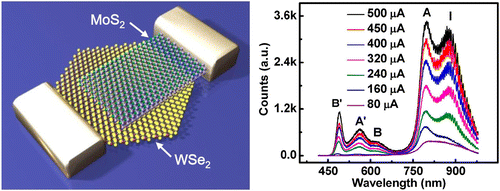Publications
Electroluminescence and Photocurrent Generation from Atomically Sharp WSe2/MoS2 Heterojunction p–n Diodes
R. Cheng, D. Li, H. Zhou, C. Wang, A. Yin, S. Jiang, Y. Liu, Y. Chen, Y. Huang and X. Duan
Nano Lett. 14, 5590-5597 (2014)

The p–n diodes represent the most fundamental device building blocks for diverse optoelectronic functions, but are difficult to achieve in atomically thin transition metal dichalcogenides (TMDs) due to the challenges in selectively doping them into p- or n-type semiconductors. Here, we demonstrate that an atomically thin and sharp heterojunction p–n diode can be created by vertically stacking p-type monolayer tungsten diselenide (WSe2) and n-type few-layer molybdenum disulfide (MoS2). Electrical measurements of the vertically staked WSe2/MoS2 heterojunctions reveal excellent current rectification behavior with an ideality factor of 1.2. Photocurrent mapping shows rapid photoresponse over the entire overlapping region with a highest external quantum efficiency up to 12%. Electroluminescence studies show prominent band edge excitonic emission and strikingly enhanced hot-electron luminescence. A systematic investigation shows distinct layer-number dependent emission characteristics and reveals important insight about the origin of hot-electron luminescence and the nature of electron–orbital interaction in TMDs. We believe that these atomically thin heterojunction p–n diodes represent an interesting system for probing the fundamental electro-optical properties in TMDs and can open up a new pathway to novel optoelectronic devices such as atomically thin photodetectors, photovoltaics, as well as spin- and valley-polarized light emitting diodes, on-chip lasers.
UCLA, Department of Chemistry and Biochemistry
607 Charles E. Young Drive East, Box 951569
Los Angeles, CA 90095-1569
E-mail: xduan@chem.ucla.edu
607 Charles E. Young Drive East, Box 951569
Los Angeles, CA 90095-1569
E-mail: xduan@chem.ucla.edu







